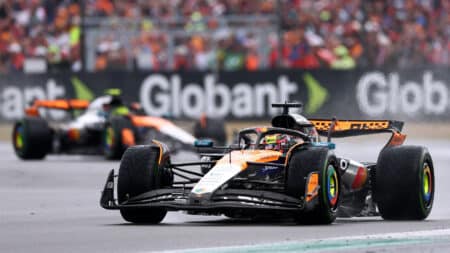
Horner's departure shows age of the maverick F1 boss is over
Christian Horner has now left Red Bull, the last of a certain breed of F1 team principal
Despite being the chairman of Prodrive, David Richards has never been too busy to chat. Within 24 hours of sending an email asking if he had any time to spare, a date and time had been set.
When I arrive at Prodrive’s temporary factory – the old one has been demolished and a new one is being built down the road – he asks if it’s OK to sign a couple of things before we start. He’s sat behind his desk – a rear aileron off a Douglas DC-3 – and his customary stubble is evident as he finishes and looks up.
Richards has been immersed in motor sport for nearly 40 years. He co-drove Ari Vatanen to his 1981 World Rally Championship, he’s managed rally teams and founded Prodrive. With the Banbury-based motor sport business he’s won the BTCC (in 1988 and 2000), the WRC (in 1995, ’96, ’97, ’01 and ‘03) and the GT class at Le Mans (in 2003, ‘07, ‘08). Oh, and he was a team principal in Formula 1 at BAR from 2002-04.
Six years ago, when F1 was on the hunt for new teams, Richards put Prodrive’s name forward, keen to get back into the top echelon of the sport. With the current financial problems in F1 it seemed a good idea to quiz the man behind the aileron. He was no doubt quite relieved his entry wasn’t accepted?
“You have to remember,” Richards says in his usual quiet and measured way, “that we put an entry forward at a time when it was agreed in principal that you would have second teams. You would basically have customer teams. Our entry was put forward on the premise of being a second team to McLaren and taking McLaren’s cars and engines. We’d run a B team alongside them with young drivers or whoever. That business, in my view, would work.”

The powers that be, however, decided that wasn’t the way they wanted to go. A budget cap was seen as the way forward and the rest, as they say, is history. Bernie Ecclestone is currently saying that it’s the fault of the small teams that they’re bankrupt – they’re spending more than they earn. While the small teams say that it’s unfair they don’t get more money for competing.
“There’s an artificial set of circumstances that people haven’t taken full acknowledgement of,” Richards counters. “From the big pot of money a big slug is taken off straight away and that goes to the Ferraris, the McLarens – we could debate about that one already… But those teams have been a mainstay of the championship for a long time. The argument is that the fans come to watch them rather than the teams at the back. It’s not dissimilar in many other sports.
“The balance of the funds is then split in two – half of it is split equally between the teams one to 10 and then the other half is split by the previous season’s performance. The thing that distorts the situation at the moment at the back of the grid is that if there were only 10 teams and the money went down to 10th place, the 10th team would only have to spend what it had available. But because there were eleven the bottom three teams spend more money than they have available because they have to get into the top 10. That’s the problem the likes of Caterham and Marussia have faced.”
It’s a topic that Richards is clearly interested in as he’s not done yet. “You have to remember Ed that the people writing the rules are the same people who would be out of a job if they did things like simplified the wings to make it cheaper. You let engineers get their hands on the cash and they will run away with it!
“Formula 1 for a long time has been dominated by people with an aerodynamics background and hence aerodynamics have been the prevalent performance differentiator for a number of years. This year you’ve seen engines come to the fore and every so often it takes another turn. Quite frankly, though, if you asked the people in the grandstands at Silverstone what they’d rather see – the current, very technologically interesting, highly sophisticated, small turbine engines or a screaming DFV in the back of the cars I know what the answer would be. And I know what the cost implication would be as well.
“We’ve led ourselves to believe that we’re doing the right thing – introducing green technologies and giving ourselves extraordinary technical challenges, which, to be fair, have been a part of F1 all along… But we’ve shot ourselves in the foot by some of those actions.”

Only last week Red Bull team principal Christian Horner was saying that a move back to the V8s would be a good idea. Interestingly, no one from a team that runs a Mercedes power unit has had a similar idea, but Richards wasn’t suggesting we undid all the decisions that have been made. He’s been around motor sport for long enough to know what it takes to create a successful sport. Whether it’s F1, WRC or even GT racing he has a very simple recipe.
“If you want a successful motor sport formula,” he says after conversation moves onto the GT racing, “you start by getting the product right. The core of the action has to be exciting – it has to be appealing to the public and it has to capture their imagination. That’s the success of sports car racing at the moment: it looks exciting, it is exciting. Does the product make for good racing? Well, the balance of performance has made for sensational racing… You then need to look at the format of the event. That’s where GTs have let themselves down, but the Blancpain Sprint Series has addressed that by having shorter races.
“GT racing’s popularity is going from strength to strength, but if you look at rallying, I just don’t think the core of the action is as exciting as it used to be. The old days of Audi Quattros, Peugeot 205s… all those Group B cars and even the ones subsequent to those – there was some great and exciting product out there. My sons would look at those cars and say ‘wow’. Do they get excited about a Volkswagen Polo? Or a Ford Fiesta? I’m afraid not and that’s the fundamental issue for the sport. We’ve dressed it up, we’ve tried other ways of doing it, we’ve played with the rules… We’ve got to go back to the core of the business, which is the motor car.”
I mention Rallycross and its recent rise in popularity and before I can finish Richards excitedly says “There you go! Those cars are exciting and they breathe fire out of the exhausts, they look spectacular.”
It was only in 2011/12 that Prodrive was involved in the WRC with its factory-backed Mini project. It was a short-lived programme – after BMW withdrew its works support – but Richards doesn’t have any regrets about not pursuing Prodrive’s WRC involvement. “Everything we do has to have a business case behind it,” he reasons. “The economics of the WRC didn’t make sense to us.”
What has made sense is a WRC-type Volkswagen Golf, though… On the face of it the Prodrive Golf is an odd concept – it’s a WRC car, which isn’t homologated for the WRC. There is, of course, method behind the move. Richards believes that the WRC’s rules have allowed the cars to become too sophisticated and “more technical than necessary”. It’s a barrier to any normal person who wants to run a car.

“We looked at that and the irony is that you don’t need to change many parts to dramatically reduce the costs. Clearly safety isn’t something you compromise on and the Volkswagen is beyond current FIA standards, but in place of the WRC’s highly stressed 1.6-litre turbo is a less-stressed, 2-litre engine giving more power. We’ve also taken a pragmatic and practical view on aerodynamics in order to keep costs down [the car comes with a rough price tag of £325,000 excluding taxes].”
It’s not compliant to the letter of the regulations, but “the principle of everything is correct”. Consequently there are plenty of countries out there that will allow the car to run. John Gaw, Prodrive’s motorsport managing director explained a little further: “There is more freedom in the Chinese regulations and that has helped us to create this car in such a short time frame. However, while the first cars will initially compete in China, the car can readily be modified to compete in most ‘open’ class rally series, of which there are many in Europe, Asia and North America.” The fact that Prodrive could base many of their calculations on what they’d learnt with the WRC Mini was a huge help.
So how’s it gone? It won’t surprise you to know that it was a success straight out of the box. On the weekend of November 8/9 Chris Atkinson and Stéphane Prévot won its first event – the Longyou Rally in China – by over five minutes. Not bad when you consider that the design of the car was started in June and it was shipped to China in October.

As time is running out we get onto Prodrive/Aston Martin’s plans the following year (they are carrying on as they are) and how the World Endurance Championship is going. Richards has never hidden his desire to get rid of the LMP cars and have solely GTs racing, but that’s clearly not going to happen any time soon. “I’ve actually now proposed something else to the ACO,” he says as we’re standing up. “The challenge we face is that we are seen as a class or a subset of the WEC. I can see the sense in us being in the same race, I’m not objecting to that, but I believe that the GTEs should become the World Sportscar Championship. You have the WEC for the LMPs and then the WSC for us – both taking place on the same track at the same time. Instead of saying ‘we finished first in our class’ you can tell people ‘we won the WSC’. I’ve been promoting that very strongly with the ACO and I’ll continue to do so.” Typically of Richards, it’s a well-thought-out idea.
Even before I’ve walked out of Prodrive’s door its chairman is onto the next challenge, applying his 40 years of experience in the sport. It’ll be interesting to see whether the idea of customer cars in Formula 1 makes a return and whether that will mean interest from Prodrive once again.

Christian Horner has now left Red Bull, the last of a certain breed of F1 team principal

Was Oscar Piastri the real winner in the long run after Silverstone? asks James Elson

Lewis Hamilton hadn't won in almost three years – and then produced a sensational victory at Silverstone 2024. James Elson explains why it was his best ever

Describing this year's championship race as a 'battle' might be slightly over-egging it, writes James Elson